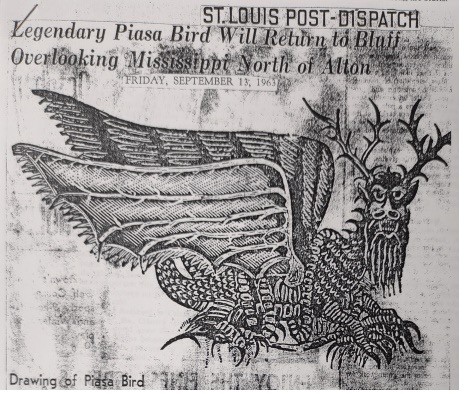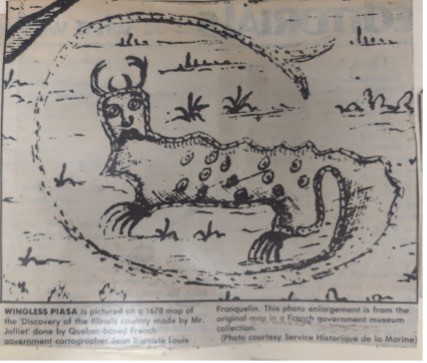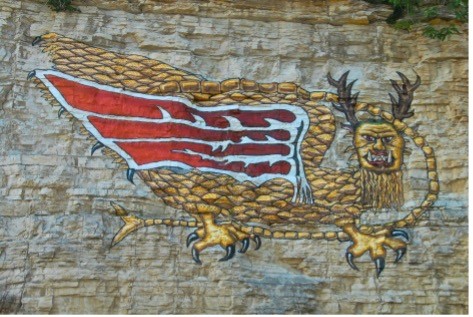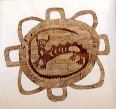Piasa Bird
Introduction
Text-to-speech Audio
Now located along the Great River Road in Alton, Illinois, the Piasa Bird serves as an important and fascinating piece of local Native American history. Though there has been much debate about the origins of this mythic creature, the lore surrounding it has become an integral part of Alton's culture that has seen many forms throughout the years.
Images




Backstory and Context
Text-to-speech Audio
One of the most puzzling pieces of Native American art is a painting found on the rock wall of a bluff in the northern part of present-day Alton, Illinois. Known today as the Piasa Bird, this artwork was first seen by Europeans when the French explored the Mississippi River in 1673. Father Jacques Marquette’s journal of the Joliet expedition provided the earliest description of the Piasa Bird: “…while skirting some rocks, which by their height and length inspired awe, we saw upon one of them two painted monsters which at first made us afraid, and upon which the boldest savages dare not long rest their eyes…they are as large as a calf; they have horns on their heads like those of a deer, a horrible look, red eyes, a beard like a tiger's, a face somewhat like a man's, a body covered with scales, and so long a tail that it winds all around the body, passing above the head and going back between the legs, ending in a fish's tail…”
Based on Marquette’s description, French cartographer Jean Baptiste Louis Franquelin drew an illustration of the Piasa Bird for a 1678 map. This description and drawing were largely forgotten until 1980. Without the benefit of this early description and illustration, later chroniclers described the drawing based on local legend. In 1836, a local Alton resident, John Marshall, wrote a description of the Piasa Bird using an 1825 drawing by a man named William Dennis. Compared to Marquette’s description and Franquelin’s illustration, the Marshall description is largely fanciful, adding exaggerated physical features such as wings. Marshall embellished his description of the Piasa Bird with a fabricated story describing how the Piasa Bird terrorized and ate Native American people. He further claimed a Native American champion, Ouatoga, defeated the creature by acting as live bait.
Jerome Jacobson, a scholar who has researched the origins of the Piasa Bird, contends that much of Marshall’s story is based on an account by the Sauk chief, Black Hawk, who described a visit to a cave where he met a benevolent creature he described “as a friendly cave-dwelling spirit who was white and had large wings like a swan’s, but ten times bigger.” Jacobson argues that the word “Piasa” came from the Illini word “pizha,” or “tiger,” indicating that the Piasa was more feline than bird. Jacobson suggested that the creature the Illini described was likely a panther or cougar. He also found that other Native American tribes used a similar word to describe a mythical “underwater panther.”
Quarrying destroyed the original Piasa Bird in 1860. Renditions attempted to recreate the artwork in 1924, 1950, and 1983, all of which were also destroyed because of development. Due to congestion caused by tourism traffic, the city removed and scrapped a steel sculpture of the Piasa Bird at Norman’s Landing in 1995. Alton was left without its” Piasa Bird” until it found a location on a bluff wall by the Great River Road in a 22-acre park provided by ConAgra Inc. Work on the new painting began in early spring of 1997 and finished in the fall of 1998. The depiction of the Piasa Bird from 1998 until today is based upon Marshall’s questionable work. Despite the controversy surrounding the history of the Piasa Bird, the image has been adopted by businesses and schools and is deeply rooted in Alton’s history.
Written by Reed Richardson, Edited by Jessica Guldner
Sources
“Anthropologist debunks local legend of Piasa Bird.” Edwardsville, Intelligencer (Edwardsville, Illinois), June 21, 1999.
“Archeologist believes Piasa was more cat-like than fowl.” Alton Telegraph (Alton, Illinois), Dec. 7, 1985.
Bell, John R. “Legendary Piasa Bird Will Return to Bluff Overlooking Mississippi North of Alton.” St. Louis Post-Dispatch (St. Louis, Missouri), Sept. 13, 1963.
Bosworth Jr. Charles. “Piasa Bird To Be Resurrected.” St. Louis Post-Dispatch (St. Louis, Missouri), Jan. 18, 1996.
Brinkmann, Paul A. “Piasa rising again with flying colors.” Alton Telegraph (Alton, Illinois), Sept. 4, 1998.
Hurley, Sue. “The Legend of the Piasa.” Alton Telegraph (Alton, Illinois), Aug. 18, 1996.
McMurroy, Dennis. “State archeology clips Piasa’s wings.” Alton Telegraph (Alton, Illinois), Dec. 7, 1985.
“Piasa Bird draws interest, artists back to its perch.” St. Louis Post-Dispatch (St. Louis, Missouri), Sept. 16, 1998.
“Piasa Bird Still Lures The Curious: Fact or Fantasy.” Highlander News Reader (Alton, Illinois), June 27, 1983.
“Piasa flies coop: Icon of legend trucked to scrap firm.” Alton Telegraph (Alton, Illinois), June 21, 1995.
